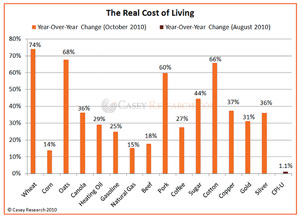
Recent riots in North Africa and the Middle East are and will continue to have a harmful impact on the private and public sectors in the United States. Egypt’s collapse has become the “Tipping Point” of a systemic contagion growing throughout North Africa and the Middle East, the likes of which we have not witnessed since World War II. Indeed, the turbulent geopolitics of this region of the world will no doubt continue into the foreseeable future.
So, what in the world does all this chaos have to do with the SHE professions? Actually, this chaos presents SHE professionals with an opportunity to break out of their technocratic, compliance-driven mindset in performing SHE work and start thinking differently. Whether you know it or not, your organizations and employees are feeling the pain of rising costs and inflation. For instance, last October, Casey Research published the following chart depicting the “Real Cost of Living.” [i]
According to the latest Consumer Price Index (CPI-U) data published by the Bureau of Labor Statistics for January 2011, the CPI-U was 1.6%. [i] Obviously, there are a multitude of reasons, not the least of which is politics, that our government’s CPI-U is reported so much lower than what the real costs of products are in the marketplace. Have you noticed the prices of food and gasoline soaring in the past year?
From a SHE professional’s perspective, note the explosion in the price of commodities, namely heating oil, gasoline, natural gas, copper, silver and gold. Raw agriculture costs are skyrocketing. These data reflect conditions in October of last year. As of this writing, oil prices are at or above $100/barrel compared to the low $80s in October 2010. Forecasters predict gasoline to be well above $4/gallon before year-end. Virtually every business has to purchase these commodities in order to operate. In part, this is the reason companies are sitting on large amounts of cash.
Another benchmark indicator to track is the St. Louis Federal Reserve’s Adjusted Monetary Base, which depicts the amount of money in circulation as illustrated in the following two charts. [ii] Simply stated, the more paper money in circulation the less your dollar is worth or, in other words, more paper money stimulates higher inflation.
Searching for areas to reduce costs
The marketplace does not like volatility some of which is being generated by the unrest in North Africa and the Middle East and some of which is driven by homegrown behavior. To an extent, this volatility is causing the price of raw materials and feedstock to shoot through the roof and driving higher inflation. Even though companies are sitting on large sums of cash waiting for more stability in the marketplace, every company is searching for areas to reduce costs.
Herein lies the opportunity for SHE professionals to explore new and innovative ways to deliver safety, industrial hygiene and environmental projects in a more cost effective and efficient manner. Frankly, with all of this volatility, there is no time like the present for SHE professionals to learn and understand how financial decisions are made in their business.
Seek out the financial decision makers in your company and ask them to explain what drives their decisions. Go armed with questions that surface understanding so that you can ascertain how to propose new approaches to doing SHE work that management can support. If your company is publicly traded, learn how to read and understand your company’s annual report. Incorporate what you have learned into your SHE proposals. Believe me, you will have management’s undivided attention.

Do we really need I2P2 right now?
Learn how to think both systemically and incrementally. Too many SHE professionals belong to the “all-or-nothing” school of SHE work. Think of your SHE work in the same fashion business people think of growing their business. What SHE activities can your business tolerate in the current business climate? Is the time really right for introducing behavior-based safety?
Many SHE professionals are involved in sustainability initiatives that, at best, are touchy-feely, public relations activities geared toward communicating how GREEN a company is to the public and their customers. SHE professionals need to throw away their plastic pocket protectors, roll up their sleeves, and dig into the numbers. For example, an article in Forbes last month highlighted Hyundai Motor’s focus on building lighter cars through the manufacturing of their own high-tensile steel to reduce the weight of their vehicles in order to achieve the new government mandated mileage standards. [i] Nowhere in the article is there any mention of sustainability or corporate social responsibility or whatever happens to be the sustainability rubric of the day. The article is all about applying sustainability principles to make more profit from a lighter vehicle that cost less to manufacture, has more horsepower, a higher safety rating, and achieves more miles per gallon. This is the kind of work SHE professionals need to become engaged in versus being “desk jockeys” filling out government forms.
Speaking of government forms, do we really need an injury and illness prevention program (I2P2) right now? The latest Bureau of Labor Statistics shows a continuing decline in all measured categories of injuries and illness rates in the private sector since 2003. [ii] Frankly, Federal, State and Local government employees would benefit more from an I2P2-type program based on their statistics.
Profitability with fewer workers
I realize several safety and health organizations have advocated to OSHA’s Assistant Secretary to implement I2P2, but layering another set of regulatory requirements on the private sector at this fragile economic and geopolitical moment in time, when the evidence shows it is not necessary, will only lead to higher costs of goods and services and a further increase in unemployment. Federal and state OSH agencies have a plethora of laws and regulations at their disposal to enforce safety and health in workplaces. For those safety and health professionals who think requiring I2P2 will endear them to their employer, you might want to revisit that thought.
Even though efforts have been underway to reduce the unemployment rate, which is officially reported at 9.0% as of January 2011 (the total unemployment rate is 16.1% as of January 2011), seasonally adjusted, companies are not hiring. [i] To some extent, the recession we have been experiencing for the past several years has lasted long enough to allow companies to learn how to maintain and, in many cases, increase profitability with fewer workers.
The volatility in the marketplace and geopolitical conflicts abroad provide SHE professionals the occasion to think differently about practicing their profession to deliver creative approaches to safety, industrial hygiene and environmental solutions.
One area that is finally beginning to gain attention is Stress in the Workplace. With all the competitive and governmental pressure companies are facing and the anxiety employees are dealing with from the grocery store, to the gasoline pump, to tuition, to layoffs, reducing workplace stress is an area ripe for a great deal of attention. Systems thinkers strive to find leverage points within a system that, if dissolved, will lead to the eliminating problems in the system. For me, focusing on workplace stress is one of those leverage points that will have concomitant effects leading to a more productive, safer, healthier, and environmentally responsive workplace.


